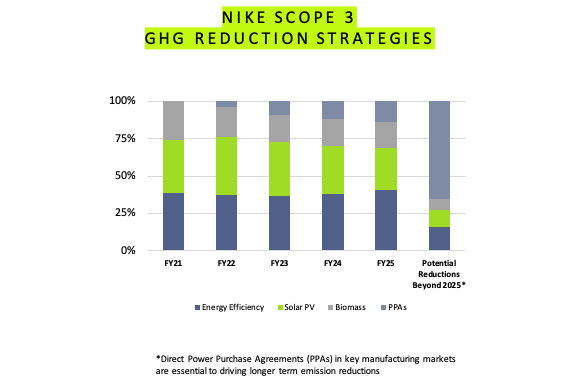With climate change affecting athletes around the world, Nike is committed to reducing emissions across our value chain, industry, and beyond.
Nike’s Responsible Sourcing and Manufacturing (RSM) Climate & Energy Program works with our suppliers globally to reduce emissions and improve energy efficiency, contributing to the achievement of our enterprise climate goals.
One pillar of the RSM Climate & Energy Program is on-site solar photovoltaic (PV) deployment, which is a major lever in support of achieving our ambitious Scope 3 emissions targets. Nike’s targets include a 2025 target to hold manufacturing emissions at 2020 levels despite anticipated production grown and then reduce emissions by 30% across the extended supply chain by 2030. Nike’s strategy to reduce emissions over the next five years includes continuing to implement energy efficiency measures at factories, eliminating coal in textile dyeing and finishing, deploying on-site renewables at factories and advocating for regulation that will allow suppliers to purchase off-site renewable energy. Electricity accounts for over 70% of Nike supplier emissions, making renewable electricity the most important lever in our strategy. On-site solar PV can typically cover 10-15% of electricity requirements at Nike supplier facilities and can be scaled quickly across sites, thus making it a major component of our renewable energy strategy with suppliers.

Solar PV is also a cost-effective solution for reducing emissions. Costs of on-site solar installations have fallen to the point where they can be less expensive than grid-purchased electricity, thus potentially offering financial savings for suppliers while also reducing their carbon footprint.
The Nike On-site Solar PV Program launched in FY19 and has helped more than 30 of our supplier factories across Asia install rooftop solar PV, including 15 sites in China. Through the program, Nike provides technical advice and assistance, helping to reduce risk for our suppliers during the contracting process and make the business case for these investments.
During Nike’s FY21, suppliers nearly doubled their on-site solar PV capacity in China from 20.9 MW to 39 MW. Another 23.5 MW are currently under negotiation between our manufacturing suppliers and solar developers. These projects are estimated to produce over 80,000 MWh electricity and avoid 50,000 tons CO2e per year.
Since on-site solar is currently cost-competitive and widely available, it is a great first step in helping our suppliers in China reduce their emissions footprint.
In addition to on-site solar PV, power purchase agreements (PPAs) could enable suppliers to reduce their emissions by over 90 percent and potentially eliminate their emissions associated with purchased electricity. Nike is currently exploring policy frameworks to support PPAs in China and seeks to help our suppliers engage where opportunities exist (such as provincial pilots).
Overall, by expanding the renewable electricity solutions at our suppliers’ disposal, Nike hopes to continue accelerating emission reductions toward meeting long-term climate targets in the coming years.
If any divergences arise between the English and the Chinese versions of this report, please refer to the English version.
(The above content is provided by the brand, and the authenticity of the data is the responsibility of the brand)